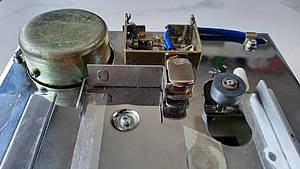Stereo-Pak
This article needs additional citations for verification. (June 2016) |
| Stereo-Pak logo | |
| Media type | magnetic tape |
|---|---|
| Encoding | analog signal |
| Read mechanism | tape head |
| Write mechanism | magnetic recording head |
| Developed by | Earl Muntz |
| Usage | Car audio playback |
The Muntz Stereo-Pak, commonly known as the 4-track cartridge,[1] is a magnetic tape sound recording cartridge technology.
The Stereo-Pak cartridge was inspired by the Fidelipac 3-track tape cartridge system invented by George Eash in 1954 and used by radio broadcasters for commercials and jingles beginning in 1959. The Stereo-Pak was adapted from the basic Fidelipac cartridge design by Earl "Madman" Muntz in 1962 with Muntz partnering with Eash, as a way to play prerecorded tapes in cars.[2][3][4]
The tape is arranged in an infinite loop which traverses a central hub and crosses a tape head, usually under a pressure pad to assure proper tape contact. The tape is pulled by tension, and spooling is aided by a lubricant, usually graphite.[5]
History
The endless loop tape cartridge was designed in 1952 by Bernard Cousino of Toledo, Ohio.[6][7]
Entrepreneur Earl "Madman" Muntz of Los Angeles, California, saw a potential in these broadcast carts for an automobile music tape system, and in 1962 introduced his "Stereo-Pak 4-Track Stereo Tape Cartridge System" and prerecorded tapes, initially in California and Florida. He licensed popular music albums from the major record companies and duplicated them on these 4-track cartridges, or CARtridges, as they were first advertised. Previously, music in the car had been restricted mostly to radios. Records, due to their methods of operation and size, were not practical for use in a car, although several companies tried to market an automobile record player including the Highway Hi-Fi and the Auto-Com flexidisc[8]
References
- ^ "The 4-Track Madman". Archived from the original on July 16, 2004. Retrieved July 7, 2004.
- ^ "Analog Stereo Formats". Archived from the original on November 2, 2011. Retrieved October 28, 2011.
- ^ Jay Ehler: Earl Muntz Meets George Eash Billboard vol. 84, No. 47, 18 November 1972, p. 62, 76, 78
- ^ Barry Kernfeld: Pop Song Piracy: Disobedient Music Distribution since 1929, The University of Chicago Press 2011 ISBN 978-0-226-43183-3
- ^ Magnetic sound recording tapes, 1963-04-02, retrieved 2018-05-02
- ^ Morton, David (2006). Sound Recording: The Life Story of a Technology. JHU Press. p. 157. ISBN 9780801883989.
- ^ Magnetic sound tape, 1955-04-11, retrieved 2018-05-02
- ^ "Auto-com Talking Book Demonstration Flexible Disc Auto-Disc". YouTube. Archived from the original on 2021-12-05.
- Articles needing additional references from June 2016
- All articles needing additional references
- Articles with short description
- Short description with empty Wikidata description
- Articles with missing files
- Audiovisual introductions in 1962
- Audio storage
- Tape recording
- Discontinued media formats
- American inventions
- 1962 in music
- 1962 in technology
- Products introduced in 1962

